Chapter 19.115
COMMUNITY DESIGN GUIDELINES
Sections:
19.115.050 Site design – All zoning districts, except CC-C.
19.115.060 Building design – All zoning districts, except CC-C.
19.115.070 Building and pedestrian orientation – All zoning districts, except CC-C.
19.115.080 Mixed-use residential buildings in commercial zoning districts.
19.115.090 District guidelines.
19.115.100 Institutional uses.
19.115.105 Self-service storage uses.
19.115.110 Design criteria for public space.
19.115.115 Design criteria for residential usable open space and fee-in-lieu option.
19.115.120 Design for cluster residential subdivision lots.
19.115.010 Purpose.
The purpose of this chapter is to:
(1) Implement community design guidelines by:
(a) Adopting design guidelines in accordance with land use and development policies established in the Federal Way comprehensive plan and in accordance with crime prevention through environmental design (CPTED) guidelines.
(b) Requiring minimum standards for design review to maintain and protect property values and enhance the general appearance of the city.
(c) Increasing flexibility and encouraging creativity in building and site design, while assuring quality development pursuant to the comprehensive plan and the purpose of this chapter.
(d) Achieving predictability in design review, balanced with administrative flexibility to consider the individual merits of proposals.
(e) Improving and expanding pedestrian circulation, public space, and pedestrian amenities in the city.
(2) Implement crime prevention through environmental design (CPTED) principles by:
(a) Requiring minimum standards for design review to reduce the rate of crime associated with persons and property, thus providing for the highest standards of public safety.
(b) CPTED principles are functionally grouped into the following three categories:
(i) Natural surveillance. This focuses on strategies to design the built environment in a manner that promotes visibility of public spaces and areas.
(ii) Access control. This category focuses on the techniques that prevent and/or deter unauthorized and/or inappropriate access.
(iii) Ownership. This category focuses on strategies to reduce the perception of areas as “ownerless” and, therefore, available for undesirable uses.
(c) CPTED principles, design guidelines, and performance standards will be used during project development review to identify and incorporate design features that reduce opportunities for criminal activity to occur. The effectiveness of CPTED is based on the fact that criminals make rational choices about their targets. In general:
(i) The greater the risk of being seen, challenged, or caught, the less likely they are to commit a crime.
(ii) The greater the effort required, the less likely they are to commit a crime.
(iii) The lesser the actual or perceived rewards, the less likely they are to commit a crime.
(d) Through the use of CPTED principles, the built environment can be designed and managed to ensure:
(i) There is more chance of being seen, challenged, or caught;
(ii) Greater effort is required;
(iii) The actual or perceived rewards are less; and
(iv) Opportunities for criminal activity are minimized.
(Ord. No. 09-604, § 3(Exh. A), 3-3-09; Ord. No. 09-593, § 34, 1-6-09; Ord. No. 07-554, § 5(Exh. A(15)), 5-15-07; Ord. No. 06-515, § 3, 2-7-06; Ord. No. 03-443, § 3, 5-20-03; Ord. No. 01-382, § 3, 1-16-01; Ord. No. 99-333, § 3, 1-19-99; Ord. No. 96-271, § 3, 7-2-96. Code 2001 § 22-1630.)
19.115.020 Administration.
Applications subject to community design guidelines and crime prevention through environmental design (CPTED) shall be processed as a component of the governing land use process, and the director shall have the authority to approve, modify, or deny proposals under that process. Unlike development standards in the zoning code, this chapter contains guidelines that are written as performance objectives for achieving siting and design solutions for each development on each unique site.
Decisions under this chapter will consider proposals on the basis of individual merit and will allow for creative design solutions to achieve the stated purpose and objectives of this chapter. To further such creative design alternatives, and in recognition of site-specific opportunities and constraints, decisions under this chapter may allow for limited departure from any specific or numeric provisions contained in these guidelines, provided the end result is consistent with the purpose of this chapter. Decisions under this chapter are appealable using the appeal procedures of the applicable land use process.
(Ord. No. 23-977, § 7, 12-5-23; Ord. No. 13-750, § 3, 11-5-13; Ord. No. 09-604, § 3(Exh. A), 3-3-09; Ord. No. 07-554, § 5(Exh. A(15)), 5-15-07; Ord. No. 06-515, § 3, 2-7-06; Ord. No. 03-443, § 3, 5-20-03; Ord. No. 01-382, § 3, 1-16-01; Ord. No. 99-333, § 3, 1-19-99; Ord. No. 97-291, § 3, 4-1-97; Ord. No. 96-271, § 3, 7-2-96. Code 2001 § 22-1631.)
19.115.030 Applicability.
This chapter shall apply to all development applications except single-family residential, or those uses exempted in specific sections, subject to this title, Zoning and Development Code. Project proponents shall demonstrate how each CPTED principle is met by the proposal, or why it is not relevant, by either a written explanation or by responding to a checklist prepared by the city. Subject applications for remodeling or expansion of existing developments shall meet only those provisions of this chapter that are determined by the director to be reasonably related and applicable to the area of expansion or remodeling. This chapter in no way should be construed to supersede or modify any other city codes, ordinances, or policies that apply to the proposal.
(Ord. No. 17-834, § 6, 5-16-17; Ord. No. 09-604, § 3(Exh. A), 3-3-09; Ord. No. 07-554, § 5(Exh. A(15)), 5-15-07; Ord. No. 06-515, § 3, 2-7-06; Ord. No. 03-443, § 3, 5-20-03; Ord. No. 01-382, § 3, 1-16-01; Ord. No. 99-333, § 3, 1-19-99; Ord. No. 97-291, § 3, 4-1-97; Ord. No. 96-271, § 3, 7-2-96. Code 2001 § 22-1632.)
19.115.040 Security program.
The following is a list of general strategies that are encouraged to be addressed in a security program for new stacked multifamily dwelling units, senior housing, or special needs housing:
(1) Develop written security policies and an emergency management plan, including evacuation procedures.
(2) Provide illumination in all areas of the building, including parking facilities and entryways to buildings, according to requirements of the Illuminating Engineering Society (IES) Lighting Handbook.
(3) Ensure that the lobby and the area immediately outside its doors are free of places of concealment for persons.
(4) Install large glass panels in lobby doors.
(5) Design buildings so that the elevator area is fully visible throughout the lobby. On levels other than the lobby floor, elevators should open directly to hallways, without recesses or blind corners that restrict two-way visibility.
(6) Locate laundry rooms in a more active area of the building, adjacent to common space or the main lobby, and install large glass windows in the laundry room.
(7) Keep laundry rooms and exercise rooms secure and accessible by residents.
(8) Locate mailboxes and mail rooms adjacent to the main lobby of the building.
(9) Store keys in a secure location and control their distribution.
(10) Control access into the building by locking all exterior entrances, including accessible roof openings, doors to accessible balconies and terraces, and parking garage entrances. Provide automatic door closures, as needed.
(11) Provide deadbolt locks, peepholes, and safety chains (night latches) on resident doors.
(12) Install a functioning high quality video monitoring system with cameras located in the lobby, elevator, playground, and parking lot.
(13) Keep plants and shrubs trimmed to provide for visibility of the building and surrounding property.
(14) Trim tree branches up from the ground in order to discourage the possibility of a person hiding.
(15) Make sure fences can be seen through.
(16) Post the site and building addresses clearly.
(Ord. No. 17-834, § 7, 5-16-17.)
19.115.050 Site design – All zoning districts, except CC-C.
(1) General criteria.
(a) Natural amenities such as views, significant or unique trees, or groupings of trees, creeks, riparian corridors, and similar features unique to the site should be incorporated into the design.
(b) Pedestrian areas and amenities should be incorporated in the overall site design. Pedestrian areas include but are not limited to outdoor plazas, arcades, courtyards, seating areas, and amphitheaters. Pedestrian amenities include but are not limited to outdoor benches, tables and other furniture, balconies, gazebos, transparent glass at the ground floor, and landscaping.
(c) Pedestrian areas should be easily seen, accessible, and located to take advantage of surrounding features such as building entrances, open spaces, significant landscaping, unique topography or architecture, and solar exposure.
(d) Project designers shall strive for overall design continuity by using similar elements throughout the project such as architectural style and features, materials, colors, and textures.
(e) Place physical features, activities, and people in visible locations to maximize the ability to be seen, and, therefore, discourage crime. For example, place cafes and food kiosks in parks to increase natural surveillance by park users, and place laundry facilities near play equipment in multiple-family residential development. Avoid barriers, such as tall or overgrown landscaping or outbuildings, where they make it difficult to observe activity.
(f) Provide access control by utilizing physical barriers such as bollards, fences, doorways, etc., or by security hardware such as locks, chains, and alarms. Where appropriate, utilize security guards. All of these methods result in increased effort to commit a crime and, therefore, reduce the potential for it to happen.
(g) Design buildings and utilize site design that reflects ownership. For example, fences, paving, art, signs, good maintenance, and landscaping are some physical ways to express ownership. Identifying intruders is much easier in a well-defined space. An area that looks protected gives the impression that greater effort is required to commit a crime. A cared-for environment can also reduce fear of crime. Areas that are run down and the subject of graffiti and vandalism are generally more intimidating than areas that do not display such characteristics.
(2) Surface parking lots.
(a) Site and landscape design for parking lots are subject to the requirements of Chapter 19.125 FWRC.
(b) Vehicle turning movements shall be minimized. Parking aisles without loop access are discouraged. Parking and vehicle circulation areas shall be clearly delineated using directional signage.
(c) Driveways shall be located to be visible from the right-of-way but not impede pedestrian circulation on site or to adjoining properties. Driveways should be shared with adjacent proper-
ties to minimize the number of driveways and curb cuts.
(d) Multi-tenant developments with large surface parking lots adjacent to a right-of-way are encouraged to incorporate retail pads against the right-of-way to help break up the large areas of pavement.
(e) See FWRC 19.115.090 for supplemental guidelines.
(3) Parking structures (includes parking floors located within commercial buildings).
(a) The bulk (or mass) of a parking structure as seen from the right-of-way should be minimized by placing its short dimension along the street edge. The parking structure should include active uses such as retail, offices or other commercial uses at the ground level and/or along the street frontage.
(b) Parking structures which are part of new development shall be architecturally consistent with exterior architectural elements of the primary structure, including rooflines, facade design, and finish materials.
(c) Parking structures should incorporate methods of articulation and accessory elements, pursuant to FWRC 19.115.060(3)(b), on facades located above ground level.
(d) Buildings built over parking should not appear to “float” over the parking area, but should be linked with ground level uses or screening. Parking at grade under a building is discouraged unless the parking area is completely enclosed within the building or wholly screened with walls and/or landscaped berms.
(e) Top deck lighting on multi-level parking structures shall be architecturally integrated with the building, and screened to control impacts to off-site uses. Exposed fluorescent light fixtures are not permitted.
(f) Parking structures and vehicle entrances should be designed to minimize views into the garage interior from surrounding streets. Methods to help minimize such views may include, but are not limited to, landscaping, planters, and decorative grilles and screens.
(g) Security grilles for parking structures shall be architecturally consistent with and integrated with the overall design. Chain-link fencing is not permitted for garage security fencing.
(h) See FWRC 19.115.090(3)(d) for supplemental guidelines.
(4) Pedestrian circulation and public spaces.
(a) Primary entrances to buildings, except for zero lot line townhouse development and attached dwelling units oriented around an internal courtyard, should be clearly visible or recognizable from the right-of-way. Pedestrian pathways from rights-of-way and bus stops to primary entrances, from parking lots to primary entrances, and pedestrian areas, shall be accessible and should be clearly delineated.
(b) Pedestrian pathways and pedestrian areas should be delineated by separate paved routes using a variation in paved texture and color, and protected from abutting vehicle circulation areas with landscaping. Approved methods of delineation include: stone, brick or granite pavers; exposed aggregate; or stamped and colored concrete. Paint striping on asphalt as a method of delineation is not encouraged.
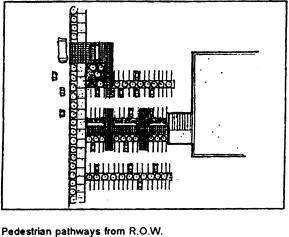
Figure 1 – FWRC 19.115.050(4)
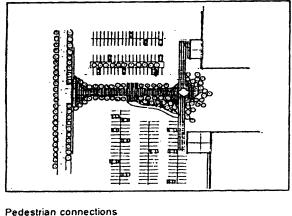
Figure 2 – FWRC 19.115.050(4)
(c) Pedestrian connections should be provided between properties to establish pedestrian links to adjacent buildings, parking, pedestrian areas and public rights-of-way.
(d) Bicycle racks should be provided for all commercial developments.
(e) Outdoor furniture, fixtures, and streetscape elements, such as lighting, freestanding signs, trellises, arbors, raised planters, benches and other forms of seating, trash receptacles, bus stops, fencing, etc., should be incorporated into the site design.
(f) See FWRC 19.115.090 for supplemental guidelines.
(5) Landscaping. Refer to Chapter 19.125 FWRC for specific landscaping requirements and for definitions of landscaping types referenced throughout this chapter.
(6) Commercial service and institutional facilities. Refer to FWRC 19.125.040 and 19.125.150 for requirements related to garbage and recycling receptacles, placement and screening.
(a) Commercial services relating to loading, storage, trash and recycling should be located in such a manner as to optimize public circulation and minimize visibility into such facilities.
Service yards shall comply with the following:
(i) Service yards and loading areas shall be designed and located for easy access by service vehicles and tenants and shall not displace required landscaping, impede other site uses, or create a nuisance for adjacent property owners.
(ii) Trash and recycling receptacles shall include covers to prevent odor and wind-blown litter.
(iii) Service yard walls, enclosures, and similar accessory site elements shall be consistent with the primary building(s) relative to architecture, materials and colors.
(iv) Chain-link fencing shall not be used where visible from public streets, on-site major drive aisles, adjacent residential uses, or pedestrian areas. Barbed or razor wire shall not be used.
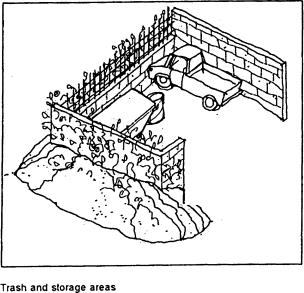
Figure 3 – FWRC 19.115.050(6)
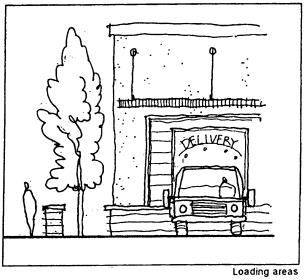
Figure 4 – FWRC 19.115.050(6)
(b) Site utilities shall comply with the following:
(i) Building utility equipment such as electrical panels and junction boxes should be located in an interior utility room.
(ii) Site utilities including transformers, fire standpipes and engineered retention ponds (except biofiltration swales) should not be the dominant element of the front landscape area. When these must be located in a front yard, they shall be either undergrounded or screened by walls and/or Type I landscaping, and shall not obstruct views of tenant common spaces, public open spaces, monument signs, and/or driveways.
(7) Miscellaneous site elements.
(a) Lighting shall comply with the following:
(i) Lighting levels shall not spill onto adjacent properties pursuant to FWRC 19.105.030(3).
(ii) Lighting shall be provided in all loading, storage, and circulation areas, but shall incorporate cut-off shields to prevent off-site glare.
(iii) Lighting standards shall not reduce the amount of landscaping required for the project by Chapter 19.125 FWRC, Outdoors, Yards, and Landscaping.
(b) Drive-through facilities, such as banks, cleaners, fast food, drug stores and service stations, etc., shall comply with the following:
(i) Drive-through windows and stacking lanes are not encouraged along facades of buildings that face a right-of-way. If they are permitted in such a location, then they shall be visually screened from such street by Type III landscaping and/or architectural element, or combination thereof; provided, such elements reflect the primary building and provide appropriate screening.
(ii) The stacking lane shall be physically separated from the parking lot, sidewalk, and pedestrian areas by Type III landscaping and/or architectural element, or combination thereof; provided, such elements reflect the primary building and provide appropriate separation. Painted lanes are not sufficient.
(iii) Drive-through speakers shall not be audible off site.
(iv) A bypass/escape lane is recommended for all drive-through facilities.
(v) See FWRC 19.115.090(4) for supplemental guidelines.
(Ord. No. 23-977, § 8, 12-5-23; Ord. No. 23-949, § 10, 2-7-23; Ord. No. 09-610, § 3(Exh. A), 4-7-09; Ord. No. 09-604, § 3(Exh. A), 3-3-09; Ord. No. 07-554, § 5(Exh. A(15)), 5-15-07; Ord. No. 06-515, § 3, 2-7-06; Ord. No. 03-443, § 3, 5-20-03; Ord. No. 01-382, § 3, 1-16-01; Ord. No. 99-333, § 3, 1-19-99; Ord. No. 96-271, § 3, 7-2-96. Code 2001 § 22-1634.)
19.115.060 Building design – All zoning districts, except CC-C.
(1) General criteria.
(a) Emphasize, rather than obscure, natural topography. Buildings should be designed to “step up” or “step down” hillsides to accommodate significant changes in elevation, unless this provision is precluded by other site elements such as stormwater design, optimal traffic circulation, or the proposed function or use of the site. See FWRC 19.120.110 for related standards for development on sites with slopes of 15 percent or greater.
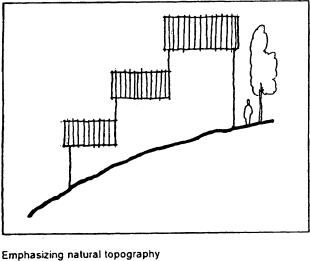
Figure 5 – FWRC 19.115.060(1)
(b) Building siting or massing shall preserve public viewpoints as designated by the comprehensive plan or other adopted plans or policies.
(c) Materials and design features of fences and walls should reflect that of the primary building(s) and shall also meet the applicable requirements of FWRC 19.120.120, Rockeries and retaining walls.
(2) Building facade modulation and screening options, defined. Except for zero lot line townhouse development and attached dwelling units, all building facades that are both longer than 60 feet and are visible from either a right-of-way or residential use or zone shall incorporate facade treatment according to this section. Subject facades shall incorporate at least two of the four options described herein; except, however, facades that are solidly screened by Type I landscaping, pursuant to Chapter 19.125 FWRC, Outdoors, Yards, and Landscaping, may use facade modulation as the sole option under this section. Options used under this section shall be incorporated along the entire length of the facade, in any approved combination. Options used must meet the dimensional standards as specified herein; except, however, if more than two are used, dimensional requirements for each option will be determined on a case-by-case basis; provided, that the gross area of a pedestrian plaza may not be less than the specified minimum of 200 square feet. See FWRC 19.115.090(3) for guidelines pertaining to city center core and city center frame.
(a) Facade modulation. Minimum depth: two feet; minimum width: six feet; maximum width: 60 feet. Alternative methods to shape a building, such as angled or curved facade elements, off-set planes, wing walls and terracing, will be considered; provided, that the intent of this section is met.
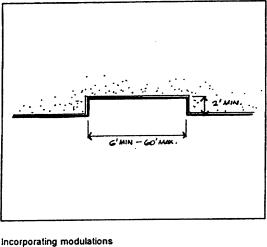
Figure 6 – FWRC 19.115.060(2)
(b) Landscape screening. Eight-foot-wide Type II landscape screening along the base of the facade, except Type IV may be used in place of Type II for facades that are comprised of 50 percent or more window area, and around building entrance(s). For building facades that are located adjacent to a property line, some or all of the underlying buffer width required by Chapter 19.125 FWRC, Outdoors, Yards, and Landscaping, may be considered in meeting the landscape width requirement of this section.
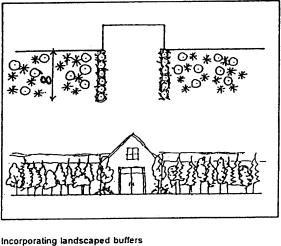
Figure 7 – FWRC 19.115.060(2)
(c) Canopy or arcade. As a modulation option, canopies or arcades may be used only along facades that are visible from a right-of-way. Minimum length: 50 percent of the length of the facade using this option.
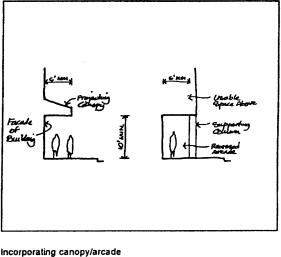
Figure 8 – FWRC 19.115.060(2)
(d) Pedestrian plaza. Size of plaza: Plaza square footage is equal to one percent of the gross floor area of the building, but it must be a minimum of 200 square feet. The plaza should be clearly visible and accessible from the adjacent right-of-way.
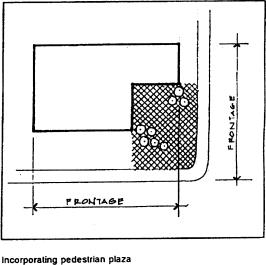
Figure 9 – FWRC 19.115.060(2)
(3) Building articulation and scale.
(a) Except for zero lot line townhouse development and attached dwelling units, building facades visible from rights-of-way and other public areas should incorporate methods of articulation and accessory elements in the overall architectural design, as described in subsection (3)(b) of this section.
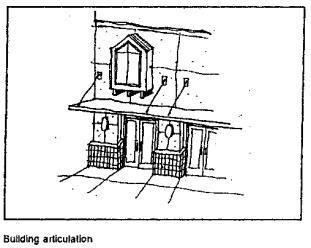
Figure 10 – FWRC 19.115.060(3)
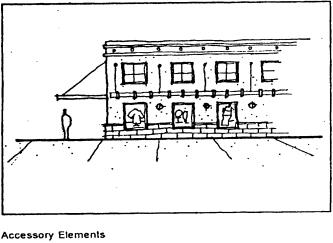
Figure 11 – FWRC 19.115.060(3)
(b) Methods to articulate blank walls. Following is a nonexclusive list of methods to articulate blank walls, pursuant to FWRC 19.125.040(22) and subsection (3)(a) of this section:
(i) Showcase, display, recessed windows;
(ii) Window openings with visible trim material, or painted detailing that resembles trim;
(iii) Vertical trellis(es) in front of the wall with climbing vines or similar planting;
(iv) Set the wall back and provide a landscaped or raised planter bed in front of the wall, with plant material that will obscure or screen the wall’s surface;
(v) Artwork such as mosaics, murals, decorative masonry or metal patterns or grillwork, sculptures, relief, etc., over a substantial portion of the blank wall surface. (The Federal Way arts commission may be used as an advisory body at the discretion of the planning staff);
(vi) Architectural features such as setbacks, indentations, overhangs, projections, articulated cornices, bays, reveals, canopies, and awnings;
(vii) Material variations such as colors, brick or metal banding, or textural changes; and
(viii) Landscaped public plaza(s) with space for vendor carts, concerts and other pedestrian activities.
(c) See FWRC 19.115.090(3) for supplemental guidelines.

Figure 12 – FWRC 19.115.060(3)

Figure 13 – FWRC 19.115.060(3)
(4) Methods to reduce building massing. The following is a nonexclusive list of methods to be utilized in construction of buildings in order to reduce their impacts on development located in an adjoining zoning district that permits less intensive residential or commercial uses:
(a) Reduce the apparent bulk of a building by breaking it into several smaller masses and varying the roof line with architectural elements.
(b) Consider options such as upper level setbacks in order to minimize bulk and shadow impacts on adjacent development.
(Ord. No. 23-977, § 9, 12-5-23; Ord. No. 17-834, § 8, 5-16-17; Ord. No. 09-610, § 3(Exh. A), 4-7-09; Ord. No. 09-604, § 3(Exh. A), 3-3-09; Ord. No. 07-554, § 5(Exh. A(15)), 5-15-07; Ord. No. 06-515, § 3, 2-7-06; Ord. No. 03-443, § 3, 5-20-03; Ord. No. 01-382, § 3, 1-16-01; Ord. No. 99-333, § 3, 1-19-99; Ord. No. 96-271, § 3, 7-2-96. Code 2001 § 22-1635.)
19.115.070 Building and pedestrian orientation – All zoning districts, except CC-C.
(1) Building and pedestrian orientation, for all buildings except zero lot line townhouse development and attached dwelling units.
(a) Buildings should generally be oriented to rights-of-way, as more particularly described in FWRC 19.115.090. Features such as entries, lobbies, and display windows should be oriented to the right-of-way; otherwise, screening or art features such as trellises, artwork, murals, landscaping, or combinations thereof should be incorporated into the street-oriented facade.
(b) Plazas, public open spaces and entries should be located at street corners to optimize pedestrian access and use.
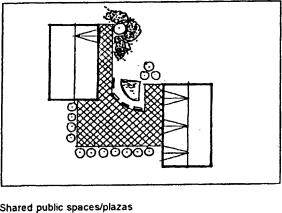
Figure 14 – FWRC 19.115.070(1)
(c) All buildings adjacent to the street should provide visual access from the street into human services and activities within the building, if applicable.
(d) Multiple buildings on the same site should incorporate public spaces (formal or informal). These should be integrated by elements such as plazas, walkways, and landscaping along pedestrian pathways, to provide a clear view to destinations, and to create a unified, campus-like development.
(Ord. No. 23-977, § 10, 12-5-23; Ord. No. 09-604, § 3(Exh. A), 3-3-09; Ord. No. 07-554, § 5(Exh. A(15)), 5-15-07; Ord. No. 06-515, § 3, 2-7-06; Ord. No. 03-443, § 3, 5-20-03; Ord. No. 01-382, § 3, 1-16-01; Ord. No. 99-333, § 3, 1-19-99; Ord. No. 96-271, § 3, 7-2-96. Code 2001 § 22-1636.)
19.115.080 Mixed-use residential buildings in commercial zoning districts.
Facades of mixed-use buildings that front a public right-of-way shall meet the following guidelines:
(1) Residential component(s) shall contain residential design features and details, such as individual windows with window trim, balconies or decks in upper stories, bay windows that extend out from the building face, upper story setbacks from the building face, gabled roof forms, canopies, overhangs, and a variety of materials, colors, and textures.
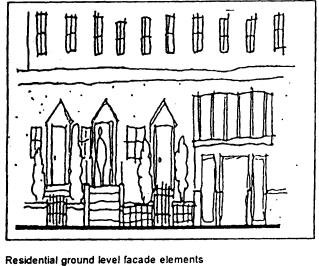
Figure 15 – FWRC 19.115.080(1)
(2) Commercial component(s) shall contain individual or common ground-level entrances to adjacent public sidewalks.
(3) Commercial and residential components may have different architectural expressions, but the facade shall exhibit a number of unifying elements to produce the effect of an integrated project.
(4) If parking occupies the ground level, see FWRC 19.115.050(3).
(5) Landscaped gardens, courtyards, or enclosed terraces for private use by residents should be designed with minimum exposure to the right-of-way.
(Ord. No. 09-604, § 3(Exh. A), 3-3-09; Ord. No. 07-554, § 5(Exh. A(15)), 5-15-07; Ord. No. 06-515, § 3, 2-7-06; Ord. No. 03-443, § 3, 5-20-03; Ord. No. 01-382, § 3, 1-16-01; Ord. No. 99-333, § 3, 1-19-99; Ord. No. 96-271, § 3, 7-2-96. Code 2001 § 22-1637.)
19.115.090 District guidelines.
In addition to the foregoing development guidelines, the following supplemental guidelines apply to individual zoning districts and/or overlay areas:
(1) Professional office (PO), neighborhood business (BN), and community business (BC).
(a) Surface parking may be located behind the building, to the side(s) of the building, or adjacent to the right-of-way; provided, however, that parking located adjacent to the right-of-way maximizes pedestrian access and circulation pursuant to FWRC 19.115.050(4).
(b) Entrance facades shall front on, face, or be clearly recognizable from the right-of-way; and shall incorporate windows and other methods of articulation.
(c) Building entrances shall be architecturally emphasized and shall incorporate transparent glass.
(d) Ground floor entrances to retail sales or services shall incorporate plaza features or furnishings, and/or streetscape amenities, in a context-sensitive amount and combination, considering the scale of the retail use(s) and entrance(s) to the overall building or development, and the proximity and access to other existing plaza or streetscape features.
(e) Ground-level mirrored or reflective glass is not allowed adjacent to a public right-of-way or pedestrian area.
(f) If utilized, chain-link fences visible from public rights-of-way or adjacent properties, and not screened by Type I landscaping as defined by Chapter 19.125 FWRC, shall utilize vinyl-coated mesh, powder-coated poles, dark color(s), and architectural element(s) such as pole caps and/or decorative grid pattern.
For residential uses only:
(g) Landscaped yards shall be provided between building(s) and public street(s). Parking lots should be beside or behind buildings that front upon streets.
(h) Parking lots should be broken up into rows containing no more than 10 adjacent stalls, separated by planting areas.
(i) Pedestrian walkways (minimum six feet wide) shall be provided between the interior of the project and the public sidewalk.
(j) Lighting fixtures should not exceed 20 feet in height and shall include cutoff shields.
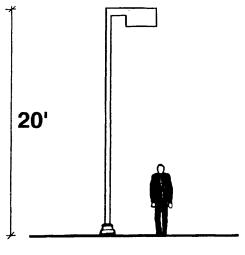
Figure 16 – FWRC 19.115.090(1)
(k) Principal entries to buildings shall be highlighted with plaza or garden areas containing planting, lighting, seating, trellises and other features. Such areas shall be located and designed so windows overlook them.
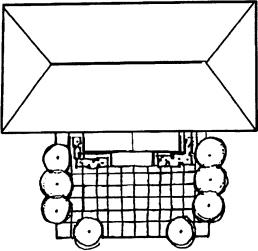
Figure 17 – FWRC 19.115.090(1)
(l) Common recreational spaces shall be located and arranged so that windows overlook them.
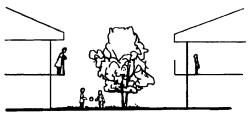
Figure 18 – FWRC 19.115.090(1)
(m) Units on the ground floor (when permitted) shall have private outdoor spaces adjacent to them so those exterior portions of the site are controlled by individual households.
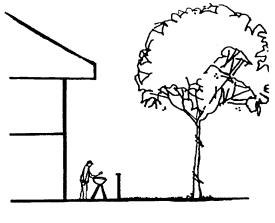
Figure 19 – FWRC 19.115.090(1)
(n) All new buildings, including accessory buildings such as carports and garages in PO and BN zones only, shall appear to have a roof pitch ranging from at least 4:12 to a maximum of 12:12.
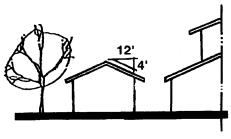
Figure 20 – FWRC 19.115.090(1)
(o) Carports and garages in front yards should be discouraged.
(p) Building facades that exceed 120 feet in length and are visible from an adjacent residential zone, right-of-way, public park, or recreation area shall incorporate a significant structural modulation (offset). The minimum depth of the modulation shall be approximately equal to 10 percent of the total length of the subject facade and the minimum width shall be approximately twice the minimum depth. The modulation shall be integral to the building structure from base to roofline.
(q) Buildings should be designed to have a distinct base, middle and top. The base (typically the first floor) should contain the greatest number of architectural elements such as windows, materials, details, overhangs, cornice lines, and masonry belt courses. The midsection, by comparison, may be simple. (Note: single-story buildings have no middle.) The top should avoid the appearance of a flat roof and include distinctive roof shapes including but not limited to pitched, vaulted or terraced, etc.
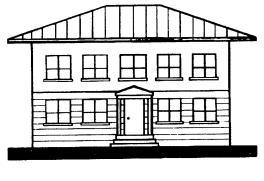
Figure 21 – FWRC 19.115.090(1)
(r) Residential design features, including but not limited to entry porches, projecting window bays, balconies or decks, individual windows (rather than strip windows), offsets and cascading or stepped roof forms, shall be incorporated into all buildings. Window openings shall have visible trim material or painted detailing that resembles trim.
(s) Subsection (1)(n) of this section shall apply to self-service storage facilities.
(2) Office park (OP) and commercial enterprise (CE).
(a) Surface parking may be located behind the building, to the side(s) of the building, or adjacent to the right-of-way; provided, however, that parking located adjacent to the right-of-way maximizes pedestrian access and circulation pursuant to FWRC 19.115.050(4).
(b) Entrance facades shall front on, face, or be clearly recognizable from the right-of-way.
(c) Building entrances shall be architecturally emphasized and shall incorporate transparent glass.
(d) Ground floor entrances to retail sales or services shall incorporate plaza features or furnishings, and/or streetscape amenities, in a context-sensitive amount and combination, considering the scale of the retail use(s) and entrance(s) to the overall building or development, and the proximity and accessibility from the building to other existing plaza or streetscape features.
(e) Ground-level mirrored or reflective glass is not allowed adjacent to a public right-of-way or pedestrian area.
(f) If utilized, chain-link fences visible from public rights-of-way or adjacent properties, and not screened by Type I landscaping as defined in Chapter 19.125 FWRC, shall utilize vinyl-coated mesh, powder-coated poles, dark color(s), and architectural element(s) such as pole caps and/or decorative grid pattern.
For non-single-family residential uses only:
(g) Subsections (1)(g) through (r) of this section shall apply.
(3) City center frame (CC-F).
(a) The city center frame contains transitional forms of development with surface parking areas. However, as new development or redevelopment occurs, the visual dominance of surface parking areas shall be eliminated or reduced.
Therefore, parking shall be located behind building(s), with building(s) located between rights-of-way and the parking area(s), or in structured parking. Any surface parking and driving areas located along a right-of-way may not occupy more than 40 percent of the project’s linear frontage along principal pedestrian right(s)-of-way, as determined by the director.
(b) Principal entrance facades shall front on, face, or be clearly recognizable from the right-of-way, and/or from the principal pedestrian right-of-way, as determined by the director, for projects exposed to more than one right-of-way.
(c) Building facades shall incorporate a combination of facade treatment options as listed in FWRC 19.115.060(2) and (3)(b), to a degree that is appropriate to the building size, scale, design, and site context, and according to the following guidelines:
(i) Principal facades containing a major entrance, or located along a right-of-way, or clearly visible from a right-of-way or public sidewalk, shall incorporate a variety of pedestrian-oriented architectural treatments, including distinctive and prominent entrance features; transparent glass such as windows, doors, or window displays in and adjacent to major entrances; structural modulation where appropriate to break down building bulk and scale; modulated rooflines, forms, and heights; architectural articulation; canopies; arcades; pedestrian plazas; murals or other artwork; and streetscape amenities. At least 40 percent of any ground level principal facade located along a right-of-way must contain transparent glass. Landscaping shall be used to define and highlight building entrances, plazas, windows, walkways, and open space, and may include container gardens, wall and window planters, hanging baskets, seasonal beds, trellises, vines, espaliered trees and shrubs, and rooftop gardens. Landscaping should not block views to the building or across the site. Foundation landscaping may be used to enhance but not replace architectural treatments.
(ii) Secondary facades not containing a major building entrance, or located along a right-of-way, or clearly visible from a right-of-way or public sidewalk, may incorporate facade treatments that are less pedestrian-oriented than in subsection (3)(c)(i) of this section, such as a combination of structural modulation, architectural articulation, and foundation landscaping.
(iii) Principal facades of single-story buildings with more than 16,000 square feet of gross ground floor area shall emphasize facade treatments that reduce the overall appearance of bulk and achieve a human scale. This may be accomplished through such design techniques as a series of distinctive entrance modules or “storefronts” framed by projecting, offset rooflines, and/or a major pedestrian plaza adjacent to the entrance.
(d) Pedestrian pathways shall be provided from rights-of-way, bus stops, parking areas, and any pedestrian plazas and public space to primary building entrances. Where a use fronts more than one right-of-way, pedestrian access shall be provided from both rights-of-way, or from the right-of-way nearest to the principal building entrance. Multiple-tenant complexes shall provide pedestrian walkways connecting all major business entrances on the site. Pedestrian pathways shall be clearly delineated by separate paved routes using a variation in color and texture, and shall be integrated with the landscape plan. Principal cross-site pedestrian pathways shall have a minimum clear width of six feet, and shall be protected from abutting parking and vehicular circulation areas with landscaping.
(e) Drive-through facilities and stacking lanes shall not be located along, or in conjunction with, a building facade that faces or is clearly visible from a right-of-way, public sidewalk, or pedestrian plaza. Such facilities shall be located along other, secondary facades, as determined by the director, and shall meet the separation, screening, and design standards listed in FWRC 19.115.050(7)(b)(ii), (iii), and (iv).
(f) Above-grade parking structures with a ground level facade visible from a right-of-way shall incorporate any combination of the following elements at the ground level:
(i) Retail, commercial, or office uses that occupy at least 50 percent of the building’s lineal frontage along the right-of-way; or
(ii) A 15-foot-wide strip of Type III landscaping along the base of the facade; or
(iii) A decorative grille or screen that conceals interior parking areas from the right-of-way.
(g) Facades of parking structures shall be articulated above the ground level pursuant to FWRC 19.115.060(3)(a).
(h) When curtain wall glass and steel systems are used to enclose a building, the glazing panels shall be transparent on 50 percent of the ground floor facade fronting a right-of-way or pedestrian area.
(i) Chain-link fences shall not be allowed. Barbed or razor wire shall not be used.
(j) For residential uses, subsections (1)(g) through (j), (l), (m), (o), (q), and (r) of this section shall apply.
(4) City center core (CC-C).
(a) Parking structures.
(i) Parking structures which are part of new development shall be architecturally consistent with exterior architectural elements of the primary structure, including rooflines, facade design, and finish materials.
(ii) Lighting shall be architecturally integrated with the building, and screened to control impacts to off-site uses. Exposed fluorescent light fixtures are not permitted.
(iii) Security grilles for parking structures shall be architecturally consistent and integrated with the overall building design.
(iv) Any roof deck parking shall be treated as a surface parking lot and shall incorporate required landscaping or architectural equivalent.
(v) Parking structures shall be designed so that vehicles parked within the parking structure are not visible from the street.
(b) Pedestrian priority.
(i) Pedestrian pathways shall be provided from rights-of-way, bus stops, parking areas, and any pedestrian plazas and public space to primary building entrances. Where a use fronts more than one right-of-way, pedestrian access shall be provided from each of the rights-of-way. Multi-tenant developments shall provide pedestrian walkways connecting all major business entrances on the site to the right-of-way. Pedestrian pathways shall be clearly delineated by separate paved routes using a variation in color and texture, and shall be integrated with the landscape plan. Principal cross-site pedestrian pathways shall have a minimum clear width of six feet.
(ii) Drive-through facilities and stacking lanes shall not be allowed.
(iii) Street wall. The building shall provide a near-continuous street wall for the length of the property breaking only for driveways, private or public outdoor spaces, and limited convenience parking. Where surface parking is provided on site, the presence of the parking will be minimized and separated from any adjacent pedestrian pathways by a three-foot-tall solid wall or three-foot-tall solid, continuous evergreen shrub hedge, and either trees or six-foot vertical ornamental design features spaced at a minimum of every 30 feet, designed to be compatible with the project.
(iv) Pedestrian weather protection.
(A) Weather protection shall be included at all public building entrances.
(B) Weather protection shall be allowed to overhang the sidewalks within public rights-of-way when permitted by a right-of-way use permit, but shall not extend over the drive lanes.
(C) Pedestrian weather protection shall include the following:
(I) Where a building wall is adjacent to a pedestrian walkway, weather protection at least four feet in width along at least 50 percent of the building facade will be provided where there is an adjacent pedestrian way. The weather protection may be in the form of awnings, marquees, canopies, or building overhangs.
(II) Canopies or awnings shall not extend higher than 15 feet above ground level or lower than eight feet at the lowest point.
(III) The pedestrian covering shall be constructed of high-quality materials such as glass, metal, or similar compatible material with the building, as determined by the director.
(v) Pedestrian areas and amenities, including but not limited to plazas, courtyards, outdoor seating and serving areas, shall be incorporated in the overall site design for every project.
(c) Fencing. Galvanized chain-link fences, electrified fencing, and barbed or razor wire shall not be permitted.
(d) Architectural guidelines. The provisions of this subsection do not apply to those properties located in the downtown architectural overlay, which are governed by subsection (5) of this section.
(i) Principal entrance facades shall front on, face, or be clearly recognizable from the right-of-way, and/or from adjacent principal pedestrian pathways.
(ii) Building facades shall incorporate a combination of facade treatment options as listed in FWRC 19.115.060(2) and (3)(b), to a degree that is appropriate to the building size, scale, design, and site context, and according to the following guidelines:
(A) Principal facades containing an entrance, or located along a right-of-way, or clearly visible from a right-of-way or public sidewalk, shall incorporate a variety of pedestrian-oriented architectural treatments, including distinctive and prominent entrance features; transparent glass such as windows, doors, or window displays in and adjacent to major entrances; structural modulation where appropriate to break down building bulk and scale; modulated rooflines, forms, and heights; architectural articulation; canopies; arcades; pedestrian plazas; murals or other artwork; and streetscape amenities.
(B) Landscaping shall be used to define and highlight building entrances, plazas, windows, walkways, and open space, and may include container gardens, wall and window planters, hanging baskets, seasonal beds, trellises, vines, espaliered trees and shrubs, and rooftop gardens. Landscaping should not block views to the building or across the site. Foundation landscaping may be used to enhance but not replace architectural treatments.
(C) Secondary facades not containing a major building entrance, or located along a right-of-way, or clearly visible from a right-of-way or public sidewalk, may incorporate facade treatments that are less pedestrian-oriented such as a combination of structural modulation, architectural articulation, and foundation landscaping.
(e) Mechanical equipment standards.
(i) Exhaust/venting, trash containers, and noise-generating mechanical systems shall not be placed adjacent to pedestrian walkways in a manner that diminishes the comfort or experience of pedestrians.
(ii) Screening is required for all exterior mechanical equipment. Screening will be placed on all exposed sides (except when a side or sides are immediately adjacent to the building). All screening will be architecturally compatible with the building architecture and will be at least as tall as the highest point of the equipment.
(f) Commercial service and institutional facilities. Refer to FWRC 19.125.150 and 19.125.040 for requirements related to garbage and recycling receptacles, placement, and screening.
(g) Commercial services relating to loading, storage, trash and recycling shall be located in such a manner as to minimize their disruption to public circulation and minimize visibility into such facilities. In addition, service yards shall comply with the following:
(i) Service yards and loading areas shall be designed and located for easy access by service vehicles and tenants and shall not displace required landscaping, impede other site uses, or create a nuisance for adjacent property owners.
(ii) Trash and recycling receptacles shall include covers to prevent odor and wind-blown litter.
(iii) Service yard walls, enclosures, and similar accessory site elements shall be consistent with the primary building(s) relative to architecture, materials and colors.
(h) Site utilities shall comply with the following:
(i) Building utility equipment such as electrical panels and junction boxes shall be located in an interior utility room or provided in an underground vault unless site circumstances prohibit these approaches.
(ii) Site utilities including transformers, fire standpipes and engineered retention ponds (except biofiltration swales) shall not be the dominant element of a provided landscape area. When these must be located in a front yard, they shall be either undergrounded or screened by walls and/or Type I landscaping, and shall not obstruct views of tenant common spaces, public open spaces, signs, and/or driveways.
(iii) Areas dedicated for utilities or service needs will be depicted on the site plan.
(i) Pedestrian priority. Drive-through facilities are prohibited.
(5) Downtown architectural overlay (DT).
(a) Vision. Within the downtown architectural overlay, the city desires a Northwest contemporary style of buildings. To achieve this vision, buildings are expected to fill the properties they are located on with little or no property uncovered by buildings. Portions of the property uncovered by buildings will provide either thoughtful community gathering spaces or small, convenient parking necessary for successful businesses.
(b) Building architecture. Buildings shall have a simple building base, and flat roofs with a cornice or similar architectural element designed with depth and detail expressing the top of the building wall. Cornices or similar architectural elements shall be well detailed and of significant proportions (height and depth) that create visual interest and shadow lines. Variation and articulation shall be applied across the facade both vertically and horizontally to create rhythm and visual interest to break up the building mass and to create a more interesting streetscape for pedestrians. This will help larger buildings appear less massive and more humanly proportioned.
(c) Materials. The richness of color and texture inherent in the materials available in the Northwest will be emphasized by layering and mixing cool and warm materials to create a well-rounded palette. Cool materials include steel, concrete, glass, and white/gray/black brick. Warm materials include natural brick and wood. Materials like metal panel, concrete, and brick can be warm or cool as desired for contrast.
(d) Examples. Illustrative examples of Northwest contemporary style in both picture and text format are included below. The standards for building architecture have been presented as lists of appropriate and inappropriate elements. This technique has been adopted to offer designers some flexibility and creativity in building design, while providing a clear expectation for architectural style:
|
Appropriate |
Inappropriate |
|---|---|
|
Source: City of Fort Worth |
Source: Lucy Sloman |
|
Source: Obsidian Architecture |
Source: Google Earth |
|
Source: Crandall Arambula |
Source: Morley von Stemberg |
|
Source: City of Spokane |
Source: Lopochina.com |
|
Source: Ryan Properties |
Source: Crandall Arambula |
|
Appropriate |
Inappropriate |
|---|---|
|
Flat roof buildings with cornice or other roofline definition to add visual interest |
Mono-pitched shed roof |
|
Penthouses or upper floor step back (step back may incorporate terraces or balconies) |
Sloped roof forms |
|
Balconies |
Metal panel as primary cladding material |
|
Tripartite composition (clear base, middle and top) required for buildings greater than five stories, optional for shorter buildings |
Blank or flat facades |
|
Building lengths less than 250 feet |
Vibrant building colors |
|
For buildings longer than 100 feet, use vertical articulation of facade (e.g., material and/or plane change) approximately every twenty-five (25) feet or aligning with structural bays creating a chaotic rhythm |
Multiple changes in facade height |
|
Siding: Brick masonry, concrete, natural stone and wood (real or synthetic) representing a minimum of 30 percent of the opaque surface material of each public-facing facade, excluding courtyards or similar structural indentations in the public-facing facade where the director determines the depth of the courtyard or indentation is greater than the width of the courtyard or indentation. The width of the courtyard or indentation is measured at the location the courtyard or indentation departs from the remainder of the public-facing facade. |
Deep overhanging roofs |
|
Masonry element at the ground level |
Color blocking as architectural detailing |
|
Green roofs and occupiable decks for aesthetics, environmental benefits, and as amenities. |
|
|
Ground floor transparency (percentage of glass as building material) a minimum of 30 percent where adjacent to a pedestrian way |
|
(e) Structured parking. Parking structures shall be designed so that vehicles parked within the parking structure are not visible from the street.
(6) For all residential zones.
(a) Nonresidential uses. Subsections (1)(a) through (f), (p) and (q) of this section shall apply.
(b) Non-single-family residential uses except for zero lot line townhouse residential uses and attached dwelling units. Subsections (1)(g) through (r) of this section shall apply.
(c) Zero lot line townhouse residential uses and attached dwelling units. Subsections (1)(j), (l) through (o), and (r) of this section shall apply.
(Ord. No. 23-977, § 11, 12-5-23; Ord. No. 23-949, § 11, 2-7-23; Ord. No. 22-932, § 20, 5-3-22; Ord. No. 10-678, § 5, 12-7-10; Ord. No. 09-610, § 3(Exh. A), 4-7-09; Ord. No. 09-604, § 3(Exh. A), 3-3-09; Ord. No. 09-593, § 36, 1-6-09; Ord. No. 07-559, § 3(Exh. A), 7-3-07; Ord. No. 07-554, § 5(Exh. A(15)), 5-15-07; Ord. No. 06-515, § 3, 2-7-06; Ord. No. 05-506, § 3, 10-18-05; Ord. No. 03-443, § 3, 5-20-03; Ord. No. 01-382, § 3, 1-16-01; Ord. No. 99-333, § 3, 1-19-99; Ord. No. 96-271, § 3, 7-2-96. Code 2001 § 22-1638.)
19.115.100 Institutional uses.
In all zoning districts where such uses are permitted the following shall apply:
(1) FWRC 19.115.050, 19.115.060 and 19.115.070.
(2) FWRC 19.115.090(1)(a), (b), (e), (f), (h) and (i).
(3) Building facades that exceed 120 feet in length and are visible from an adjacent residential zone, right-of-way or public park or recreation area shall incorporate a significant structural modulation (offset). The minimum depth of the modulation shall be approximately equal to 10 percent of the total length of the subject facade and the minimum width shall be approximately twice the minimum depth. The modulation shall be integral to the building structure from base to roofline.
(4) Roof design shall utilize forms and materials that avoid the general appearance of a “flat” roof. Rooflines with an integral and obvious architectural pitch are an approved method to meet this guideline. Alternative distinctive roof forms such as varied and multiple stepped rooflines, architectural parapets, articulated cornices and fascias, arches, eyebrows, and similar methods will be considered by the director; provided, that the roof design minimizes uninterrupted horizontal planes and results in architectural and visual appeal.
(5) Alternative methods to organize and shape the structural elements of a building and provide facade treatment pursuant to FWRC 19.115.060(2) and/or subsection (3) of this section will be considered by the director as part of an overall design that addresses the following criteria:
(a) Facade design incorporates at least two of the options listed at FWRC 19.115.060(2);
(b) The location and dimensions of structural modulations are proportionate to the height and length of the subject facade, using FWRC 19.115.060(2) and subsection (3) of this section as a guideline;
(c) Facade design incorporates a majority of architectural and accessory design elements listed at FWRC 19.115.060(3)(b) and maximizes building and pedestrian orientation pursuant to FWRC 19.115.070; and
(d) Overall building design utilizes a combination of structural modulation, facade treatment, and roof elements that organize and vary building bulk and scale, add architectural interest, and appeal at a pedestrian scale, and, when viewed from an adjacent residential zone, right-of-way, or other public area, results in a project that meets the intent of these guidelines.
(6) The director may permit or require modifications to the parking area landscaping standards of FWRC 19.115.090(1)(h) for landscape designs that preserve and enhance existing natural features and systems; provided, that the total amount of existing and proposed landscaping within parking area(s) meets the applicable square footage requirement of Chapter 19.125 FWRC, Outdoors, Yards, and Landscaping, and the location and arrangement of such landscaping is approved by the director. Existing natural features and systems include environmentally sensitive areas, stands of significant trees and native vegetation, natural topography and drainage patterns, wildlife habitat, migration corridors, and connectivity to adjacent habitats.
(7) Lighting fixtures shall not exceed 30 feet in height and shall include cutoff shields.
(Ord. No. 09-604, § 3(Exh. A), 3-3-09; Ord. No. 07-559, § 3(Exh. A), 7-3-07; Ord. No. 07-554, § 5(Exh. A(15)), 5-15-07; Ord. No. 06-515, § 3, 2-7-06; Ord. No. 03-443, § 3, 5-20-03. Code 2001 § 22-1639.)
19.115.105 Self-service storage uses.
In all zoning districts where such uses are permitted the following shall apply:
(1) Self-service storage facilities are only permitted within multistory structures designed to emulate multifamily or office buildings. Self-service storage facilities buildings shall incorporate architectural and design features common to commercial and/or multifamily development. Examples of such architectural and design features include but are not limited to: massing, proportion, facade modulation, exterior building materials and detailing, varied roof line, pedestrian scale, fenestration, and repetition.
(2) At least 40 percent of each floor of any principal facade located along a right-of-way must contain transparent glass, or material that emulates glass, such as polycarbonate, acrylic mirror sheeting, or other reflective or transparent material. All reflective or transparent materials used to satisfy this section’s requirements, other than transparent glass, must be approved by the director of the community development department.
(3) Roofline variation is required for any rooflines that exceed 50 feet in length. Roofline variation shall be achieved using one or more of the following methods:
(a) Vertical offset ridge line; or
(b) Horizontal offset ridge line; or
(c) Variations of roof pitch.
Figure 22 – FWRC 19.115.105(3)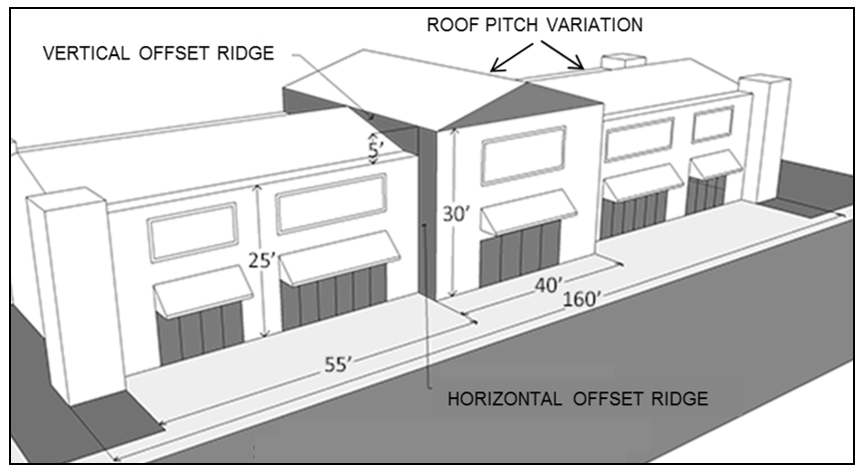
Roofline Variation
(4) The maximum building facade length is 100 linear feet, regardless of modulation, for any facade located within 50 feet of and facing a residential zoned property or right-of-way.
(5) All storage units shall be accessed from the interior of the building(s) or site – no exterior unit doors may be visible from the right-of-way or from adjacent properties.
(6) Chain-link fences shall not be allowed.
(Ord. No. 18-853, § 3, 8-14-18.)
19.115.110 Design criteria for public space.
The following guidelines apply to public space that is developed pursuant to Chapter 19.225 FWRC. All public space proposed under this section shall meet the definition of “public space” as set forth in this title and all of the following criteria:
(1) The total minimum amount of public space that shall be provided in exchange for bonus height is equal to 2.5 percent of the bonus floor area, in gross square feet; provided, that the total public space area shall not be less than 500 square feet.
(2) The public space may be arranged in more than one piece if appropriate to the site context, as determined by the director.
(3) The public space shall abut on, or be clearly visible and accessible from, a public right-of-way or pedestrian pathway.
(4) The public space shall be bordered on at least one side by, or be readily accessible from, structure(s) with entries to retail, office, housing, civic/public uses, or another public space.
(5) The open space shall not be located on asphalt or gravel pavement, or be adjacent to unscreened parking lots, chain-link fences, or on-site blank walls, and may not be used for parking, loading, or vehicular access.
(6) The open space shall be sufficiently designed and appointed to serve as a major focal point and public gathering place. It shall include a significant number of pedestrian-oriented features, furnishings, and amenities typically found in plazas and streetscapes, and as defined in this title, such as seating or sitting walls, lighting, weather protection, special paving, landscaping, trash receptacles, and bicycle racks. In addition, the open space(s) should provide one or more significant visual or functional amenity such as a water feature, artwork, or public restroom, and should allow for active uses such as vending, farmers’ markets, live performing arts space, and art shows.
(Ord. No. 09-604, § 3(Exh. A), 3-3-09; Ord. No. 09-593, § 37, 1-6-09; Ord. No. 07-554, § 5(Exh. A(15)), 5-15-07; Ord. No. 06-515, § 3, 2-7-06; Ord. No. 03-443, § 3, 5-20-03; Ord. No. 01-382, § 3, 1-16-01; Ord. No. 99-333, § 3, 1-19-99; Ord. No. 96-271, § 3, 7-2-96. Code 2001 § 22-1640.)
19.115.115 Design criteria for residential usable open space and fee-in-lieu option.
The following guidelines apply to residential usable open space that is developed pursuant to FWRC 19.200.100, 19.205.070, 19.215.150, 19.220.050, 19.220.080, 19.225.070, 19.225.075, 19.230.060, 19.230.065, and 19.240.085.
(1) Common open space. All common open space proposed under this section shall meet the definition of “open space, common” as set forth in this title and all of the following criteria:
(a) The common open space must be a minimum of 225 square feet and have a minimum dimension of 15 feet. The inclusion of additional contiguous open space areas that have smaller dimensions, but enhance the use and enjoyment of the overall larger space, may be credited toward the overall minimum usable open space requirement subject to director approval.
(b) Indoor common areas such as recreation/workout rooms, swimming pools, and gathering spaces that meet the criteria of this section may be counted as common open space subject to the criteria in this section.
(c) The common open space shall be readily visible and accessible from structure(s) with entries to residential units.
(d) The common open space shall not be located on asphalt or gravel pavement, or be adjacent to unscreened parking lots, chainlink fences, or blank walls, and may not be used for parking, loading, or vehicular access.
(e) Pedestrian access ways shall only be counted as common open space when the pedestrian path or walkway traverses a common open space that is 15 feet or wider.
(f) The common open space shall be sufficiently designed and appointed to serve as a major focal point and gathering place. Common open spaces shall include a significant number of pedestrian-oriented features, furnishings, and amenities typically found in plazas and recreational open space, such as seating or sitting walls, lighting, weather protection, special paving, landscaping, and trash receptacles. In addition, the common open space(s) should provide one or more significant visual or functional amenities such as a water feature, fireplace, and/or artwork, and should allow for active uses such as physical exercise, children’s play area, gathering area for group social events, and p-patch or other gardening activity.
(2) Private open space. A minimum of 48 square feet with a minimum dimension of six feet will be credited to usable open space.
(3) Publicly accessible open space. Publicly accessible open spaces provided on site may be credited toward the minimum residential usable open space requirement, as long as the open space is directly accessible to and available to residents for their use. Only the portion of the public open space directly accessible to and available to residents for their use may be credited toward the residential usable open space requirement.
(4) Fee-in-lieu option. A fee-in-lieu payment may be made to satisfy up to 50 percent of the residential usable open space requirement for the development of public parks and recreation improvements. Fee-in-lieu acceptance shall be at the discretion of the parks director after consideration of the city’s overall park plan, and the quality, location, and usability of the open space that would otherwise be provided on the project site. If the city determines that a fee-in-lieu is appropriate, a payment of an equivalent fee in lieu of the required open space shall be made.
The fee in lieu of open space shall be calculated based on the most recent assessed value of the subject property, or in the absence of an assessment, an appraisal conducted by a state-certified real estate appraiser. If the applicant offers to pay fee in lieu of open space, and if the city accepts the offer, the amount shall be determined based upon the square footage of open space that otherwise would have been required to be provided, multiplied by the assessed or appraised value per square foot of the property. By choosing the fee-in-lieu option, the applicant agrees that the city will not be restricted to using the fees in the park comprehensive planning area that the subject property falls within. See also FWRC 19.100.070.
(Ord. No. 23-968, § 31, 9-5-23; Ord. No. 17-834, § 9, 5-16-17; Ord. No. 12-727, § 5, 9-18-12.)
19.115.120 Design for cluster residential subdivision lots.
(1) Garages shall be provided for all residential lots except if the lot is in a multifamily zone.
(2) Front entryways should be the prominent feature of the home. Attached garages should not compose more than 40 percent of the front facade of the single-family home if the garage doors are flush with the front facade, or will be set back a minimum of five feet from the rest of the front facade. Detached garages should also be set back a minimum of five feet from the facade.
(3) If garage access is provided from alleys, the front yard setback can be reduced to 15 feet.
(4) Each dwelling unit shall be intended for owner occupancy.
(Ord. No. 09-604, § 3(Exh. A), 3-3-09; Ord. No. 03-443, § 3, 5-20-03; Ord. No. 01-381, § 3, 1-16-01. Code 2001 § 22-1641.)



_1.1811123.png)
_2.1811123.png)
_3.1811123.png)
_4.1811123.png)
_5.1811123.png)
_6.1811123.png)
_7.1811123.png)
_8.1811123.png)
_9.1811123.png)
_10.1811123.png)